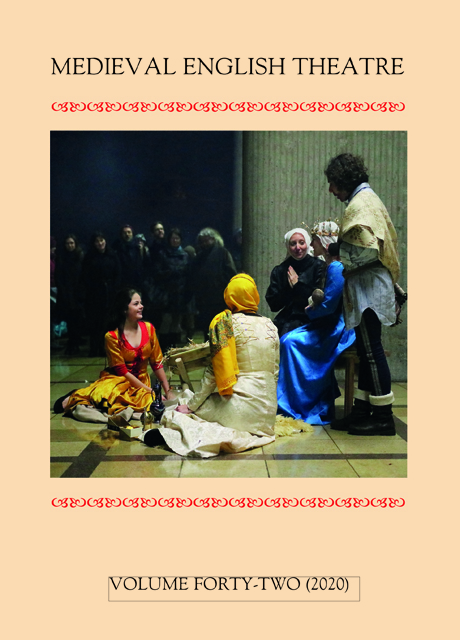Book contents
- Frontmatter
- Contents
- List of Illustrations
- List of Common Abbreviations
- Editorial
- Introduction: Reflections on the Medieval Convent Drama Project
- Fragments of Four Fourteenth-century Miracle Plays from Mont Saint-Michel
- Performing Female Authority: Convent Plays and Lay Spectatorship in the Barking Abbey Elevatio and Visitatio Sepulchri Dramatic Ceremonies
- Women in Religious Guilds: Performance and Community in Medieval and Tudor England
- When in Doubt: Thomas Indie and the Mid-sixteenth-century Reception of the Towneley Collection
- Taʿziyeh-khani in Iranian Communities: Muharram AH 1439 (AD 2017)
- Editorial Board
- Submission of Articles
Performing Female Authority: Convent Plays and Lay Spectatorship in the Barking Abbey Elevatio and Visitatio Sepulchri Dramatic Ceremonies
Published online by Cambridge University Press: 17 January 2023
- Frontmatter
- Contents
- List of Illustrations
- List of Common Abbreviations
- Editorial
- Introduction: Reflections on the Medieval Convent Drama Project
- Fragments of Four Fourteenth-century Miracle Plays from Mont Saint-Michel
- Performing Female Authority: Convent Plays and Lay Spectatorship in the Barking Abbey Elevatio and Visitatio Sepulchri Dramatic Ceremonies
- Women in Religious Guilds: Performance and Community in Medieval and Tudor England
- When in Doubt: Thomas Indie and the Mid-sixteenth-century Reception of the Towneley Collection
- Taʿziyeh-khani in Iranian Communities: Muharram AH 1439 (AD 2017)
- Editorial Board
- Submission of Articles
Summary
In the early fifteenth century Abbess Sybil of Felton saw the need to provide guidance for the future abbesses of Barking Abbey and commissioned an Ordinal and Customary recording the house’s liturgy. Its account of Easter Matins includes two ceremonies – generally named in scholarly literature the Elevatio and the Visitatio Sepulchri – that depict the Harrowing of Hell, the Resurrection, and the Visit of the three Marys to the Sepulchre. While unique, they belong to an ensemble of similar ceremonies produced in numerous medieval cathedrals, monasteries, and nunneries throughout Europe. These ceremonies were sung in Latin by their participants – nuns, priests, and clerics in the case of Barking – who explicitly took on roles and wore appropriate clothing to signify these roles. These last features of the Elevatio and Visitatio have resulted in their frequent dissociation from the rest of the liturgy and in their study as drama. Yet their categorization, as well as the common use of the term ‘liturgical drama’ to designate them, continues to provoke extensive scholarly debates. Some scholars have denied that they should be categorized as liturgical; others that they should be categorized as drama. Musicologists in particular regret the lack of reference to music in the term ‘liturgical drama’, though music is an essential feature of these events. Furthermore, because there is no consensus about the term and its definition, ‘liturgical drama’ is used as a catch-all expression to designate vastly different ceremonies, sung or spoken, performed in Latin or in the vernacular, during or outside church services. As for the nature of the Barking Abbey Elevatio and Visitatio, the current scholarly consensus, which I here follow, seems to be that they are liturgical, but feature dramatic elements otherwise absent from or less pronounced in the rest of the liturgy.
The classification of performative activities as either drama or liturgy probably depended in the Middle Ages on the perception of the audience or congregation. A ritual that was perceived to have ‘efficacy’ was liturgy, although this did not prevent it from being theatrical. Some spectators may even have recognized the more ‘dramatic’ liturgical ceremonies as close to drama, or as resonant with other theatrical experiences.
- Type
- Chapter
- Information
- Medieval English Theatre 42Religious Drama and Community, pp. 50 - 89Publisher: Boydell & BrewerPrint publication year: 2021

